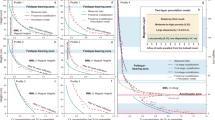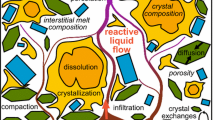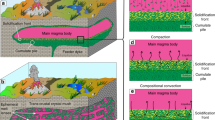Abstract
Postcumulus trapped liquid shift in layered complexes produces cumulate minerals with more fractionated compositions than the original primary phases. This effect is shown by olivine compositions from the base of the Mount Ayliff Intrusion, where varying proportions of olivine to interstitial liquid produce a suite of rocks which define a tight linear trend on a binary whole-rock plot of MgO versus FeO. Extrapolation of this trend constrains the composition of the primary cumulus olivine to the range Fo84–86, whereas olivine actually present have compositions Fo77–83. The magnitude of the discrepancy between the theoretical and observed olivine compositions correlates directly with the weight fraction of interstitial liquid. These observations are quantitatively predicted by the trapped liquid shift model. They also argue against significant migration of residual liquid. Trapped liquid shift is documented over a vertical interval of 60 m. It occurred in rocks lying only 1 m above the basal contact of the intrusion and hence must be a comparatively rapid process.
Similar content being viewed by others
References
Barnes SJ (1986) The effect of trapped liquid crystallization on cumulus mineral compositions in layered intrusions. Contrib Mineral petrol 93:524–531
Cawthorn RG, Groves DI, Marchant T (1985) Magnesian ilmenite: clue to high-Mg parental magma of the Insizwa intrusion, Transkei. Can Mineral 23:609–618
Cawthorn RG, de Wet M, Maske S, Groves DI, Cassidy KF (1986) Nickel sulphide potential of the Mount Ayliff Intrusion (Insizwa Complex) Transkei. S Afr J Sci 82:572–576
Cawthorn RG, Maske S, de Wet M, Groves DI, Cassidy KF (1988) Contrasting magma types in the Mount Ayliff Intrusion (Insizwa Complex), Transkei: evidence from ilmenite compositions. Can Mineral 26:145–160
Cawthorn RG, de Wet M, Hatton CJ, Cassidy KF (1991) Titaniumrich chromite from the Mount Ayliff Intrusion: further evidence for high titanium tholeiitic magma. Am Mineral 76:561–573
Chalokwu CI, Grant NK (1987) Reequilibration of olivine with trapped liquid in the Duluth Complex, Minnesota. Geology 15:71–74
Donaldson CH (1976) An experimental investigation of olivine morphology. Contrib Mineral Petrol 57:187–213
Eales HV (1980) Contrasted trace-element variations in two Karroo cumulus complexes. Chem Geol 29:39–48
Irvine TN (1978) Infiltration metasomatism, adcumulus growth, and secondary differentiation in the Muskox Intrusion. Carnegie Inst Washington Yearb 77:743–751
Irvine TN (1980) Magmatic infiltration metasomatism, double-diffusive fractional crystallization, and adcumulus growth in the Muskox Intrusion and other layered intrusions. In: Hargraves RB (ed) Physics of magmatic processes. Princeton University Press, New Jersey, pp 326–383
Lightfoot PC, Naldrett AJ (1984) Chemical variation in the Insizwa Complex, Transkei, and the nature of the parent magma. Can Mineral 22:111–123
Lightfoot PC, Naldrett AJ, Hawkesworth CJ (1984) The geology and geochemistry of the Waterfall Gorge section of the Insizwa Complex with particular reference to the origin of the nickel sulfide deposits. Econ Geol 79:1857–1879
Lightfoot PC, Naldrett AJ, Hawkesworth CJ (1987) Re-evaluation of chemical variation in the Insizwa Complex, Transkei. Can Mineral 25:79–90
Lofgren GE (1980) Experimental studies on the dynamic crystallization of silicate melts. In: Hargraves RB (ed) Physics of magmatic processes. Princeton University Press, New Jersey, pp 487–551
Mathison CI, Booth RA (1990) Macrorhythmically layered gabbronorites in the Windamurra gabbroid body, Western Australia. Lithos 24:171–180
Paktunc AD (1987) Differentiation of the Cuthbert Lake ultramafic dikes and related mafic dikes. Contrib Mineral Petrol 97:405–416
Raedeke LD, McCallum IS (1984) Investigations in the Stillwater Complex: Part II. Petrology and petrogenesis of the Ultramafic series. J Petrol 25:395–420
Roeder PL, Emslie RF (1970) Olivine-liquid equilibrium. Contrib Mineral Petrol 29:257–289
Scholtz DL (1936) The nickeliferous ore deposits of East Griqualand and Pondoland. Trans Geol Soc S Afr 39:81–210
Tait SR, Huppert HE, Sparks RSJ (1984) The role of compositional convection in the formation of adcumulate rocks. Lithos 17:139–146
Wilson JR, Menuge JF, Pedersen S, Engell-Sorensen O (1987) The Southern part of the Fongen-Hyllingen layered mafic complex, Norway: emplacement and crystallization of compositionally zoned magma. In: Parsons I (ed) Origins of igneous layering. Reidel, Dordrecht, pp 145–184
Author information
Authors and Affiliations
Rights and permissions
About this article
Cite this article
Cawthorn, R.G., Sander, B.K. & Jones, I.M. Evidence for the trapped liquid shift effect in the Mount Ayliff Intrusion, South Africa. Contrib Mineral Petrol 111, 194–202 (1992). https://doi.org/10.1007/BF00348951
Received:
Accepted:
Issue Date:
DOI: https://doi.org/10.1007/BF00348951




